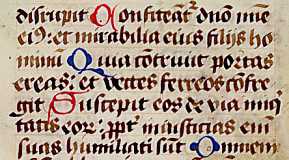Script Type : minuscule
Date : 12th to 15th centuries, this example from around 1500.
Location : Spread from France and the Low Countries across western Europe. This example is from Germany.
Function : Book hand




























Distinctive letters : This example is taken from a psalter; not an elaborate showpiece, but what is clearly a simple working text. The letter forms are those of a Gothic textura script of relatively informal type. The letters are somewhat uneven, but it has no cursive qualities, and letters are quite clearly formed and well separated. It is quite easy to read, and there are few confusions among rows of minims as letters like u and n are readily differentiated. The letters, while not compressed, are very angular.
Ascenders and descenders tend to be straight and relatively unadorned. The trickiest letter is probably c, which is flat topped and easily mistaken for a t, as in many later Gothic scripts. Intriguingly, they can sometimes be substituted for each other, as in the word iusticiam shown here.
The letter a has the simple single chambered form, while g looks like a y closed with a horizontal line at the top, as is found in German and some French cursive scripts.
The letters u and v are identical when they occur within a word, but both have a more angular form when they appear as the first letter.
Two forms of r appear, including the simplified form which appears mainly after o, and both the tall and short and curly s are present.
The letters i and j are identical, although when i is doubled the second i is elongated. The letters are dotted to allay confusion where they appear among other letters constructed of minims.
There are no examples of k, w or z.
Pass the cursor slowly over the segment illustrated to pick out some words. To have a more enthusiastic go at decoding this script, continue to the paleography exercises.
Paleography
exercises using Flash![]()
Requires at least the Flash 5 plugin
If you are looking at this page without frames, there is more information about medieval writing to be found by going to the home page (framed) or the site map (no frames).